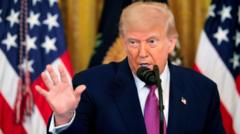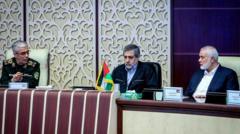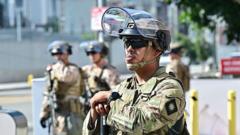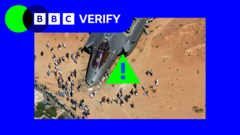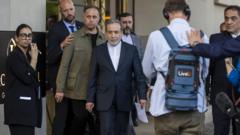In a significant escalation of conflict, President Trump announced that U.S. forces have bombed three key Iranian nuclear facilities in coordination with Israel, marking a new phase in the ongoing hostilities in the Middle East. As Iran prepares for potential reprisals, the region faces heightened uncertainty about the future of peace and security.
Tensions Escalate as U.S. Enters Conflict with Iran Over Nuclear Attacks

Tensions Escalate as U.S. Enters Conflict with Iran Over Nuclear Attacks
President Trump confirms U.S. military strikes on Iranian nuclear sites, igniting fears of a wider regional war.
In a dramatic shift in Middle East dynamics, President Trump confirmed that U.S. forces have launched attacks on critical Iranian nuclear facilities, specifically targeting Fordo, Natanz, and another site near Isfahan. This response aligns with Israel's ongoing military operations against Iran, aimed at crippling its nuclear capabilities. The announcement came amid mixed signals from the White House about the U.S. involvement in the regional conflict, raising alarms about a potential escalation into wider hostilities.
Reportedly, the strikes came shortly after President Trump's consultations with his national security team, leading to a decision to engage militarily. "All planes are now outside of Iran airspace," Trump stated in a social media post, asserting that the attacks aimed to prevent Iran from obtaining nuclear weapons. The bombings raised immediate concerns about Iran's potential retaliation against U.S. troops and interests in the Middle East.
While American officials insist their military actions are designed to secure stability in the region, Iran's leadership has vowed to retaliate, warning of severe consequences should U.S. interventions deepen. "The harm the U.S. will suffer will definitely be irreparable," threatened Iranian Supreme Leader Ayatollah Ali Khamenei, as tensions soared.
The strikes represent a significant evolution in the conflict that escalated following Israel's bombing of Iranian military and nuclear sites, which has led to casualties among Iranian military leaders. Observers suggest that the U.S. actions are aiming not only to weaken Iran’s nuclear ambitions but also to restore U.S. influence in a region where it has faced increasing challenges.
The broader implications of the attacks are now a central concern for various stakeholders in the region. Analysts worry that the military actions might provoke Iran to react vigorously, possibly leveraging its network of proxies across the Middle East. With already fractured engagements, the conflict could force neighboring countries to recommit resources or enter the fray, thus magnifying the existing volatility in the region.
As the United States and Iran navigate an increasingly hostile environment, the coming days and weeks may significantly shape the future political landscape in the Middle East, with both sides appearing unwilling to relent. The conflict poses critical considerations for international diplomacy and the potential for renewed dialogue amid rising tensions, as regional leaders call for a de-escalation of military hostilities while preparing for worst-case scenarios.
Reportedly, the strikes came shortly after President Trump's consultations with his national security team, leading to a decision to engage militarily. "All planes are now outside of Iran airspace," Trump stated in a social media post, asserting that the attacks aimed to prevent Iran from obtaining nuclear weapons. The bombings raised immediate concerns about Iran's potential retaliation against U.S. troops and interests in the Middle East.
While American officials insist their military actions are designed to secure stability in the region, Iran's leadership has vowed to retaliate, warning of severe consequences should U.S. interventions deepen. "The harm the U.S. will suffer will definitely be irreparable," threatened Iranian Supreme Leader Ayatollah Ali Khamenei, as tensions soared.
The strikes represent a significant evolution in the conflict that escalated following Israel's bombing of Iranian military and nuclear sites, which has led to casualties among Iranian military leaders. Observers suggest that the U.S. actions are aiming not only to weaken Iran’s nuclear ambitions but also to restore U.S. influence in a region where it has faced increasing challenges.
The broader implications of the attacks are now a central concern for various stakeholders in the region. Analysts worry that the military actions might provoke Iran to react vigorously, possibly leveraging its network of proxies across the Middle East. With already fractured engagements, the conflict could force neighboring countries to recommit resources or enter the fray, thus magnifying the existing volatility in the region.
As the United States and Iran navigate an increasingly hostile environment, the coming days and weeks may significantly shape the future political landscape in the Middle East, with both sides appearing unwilling to relent. The conflict poses critical considerations for international diplomacy and the potential for renewed dialogue amid rising tensions, as regional leaders call for a de-escalation of military hostilities while preparing for worst-case scenarios.




